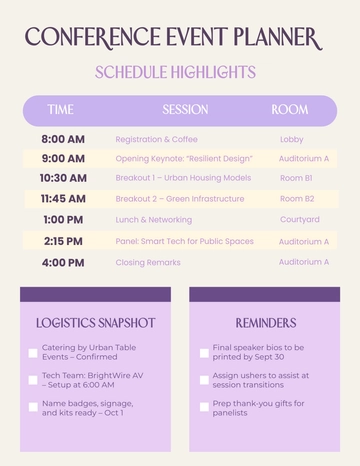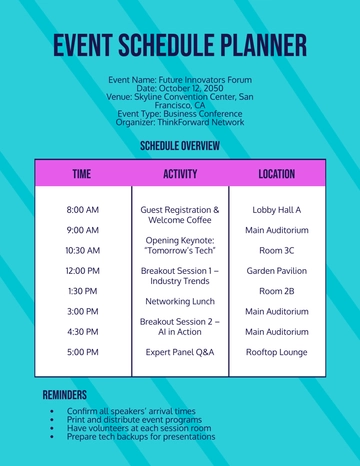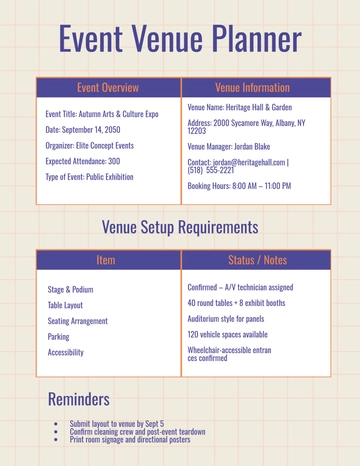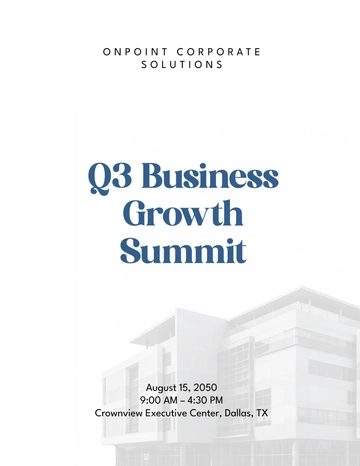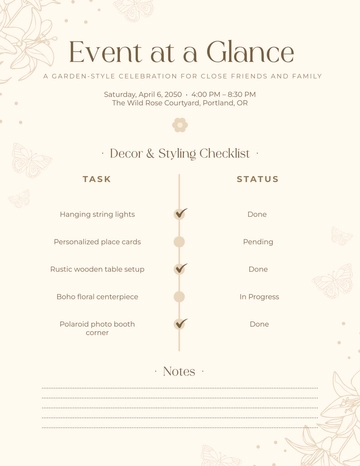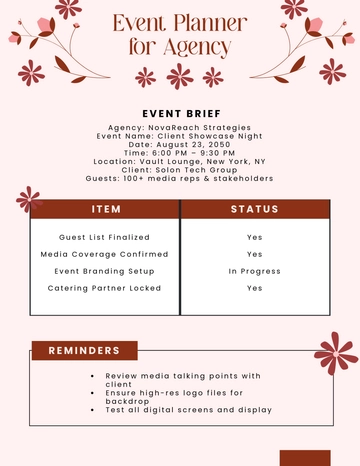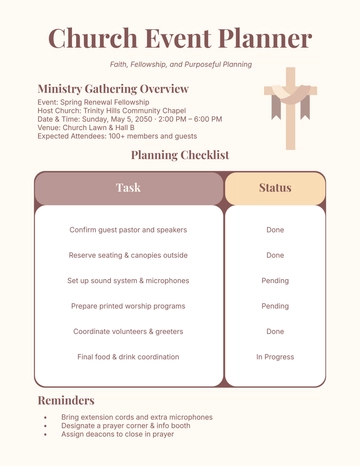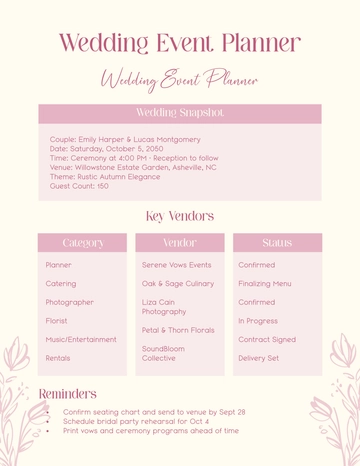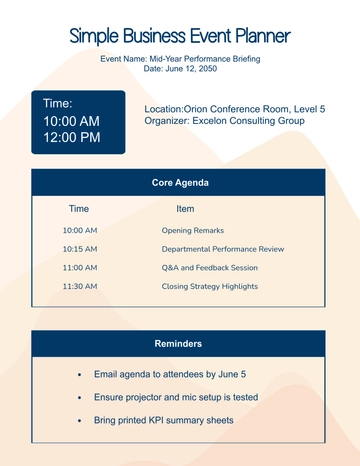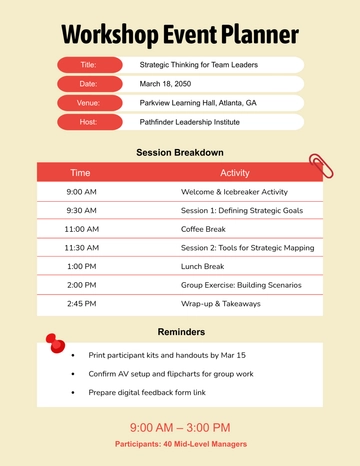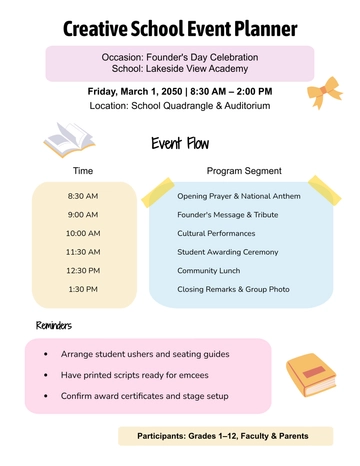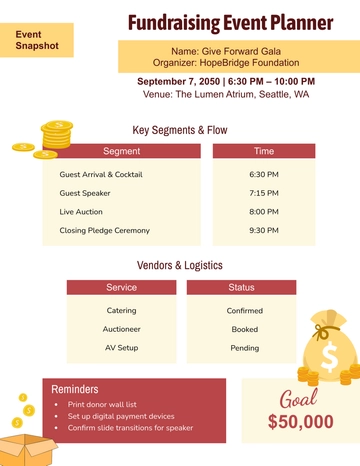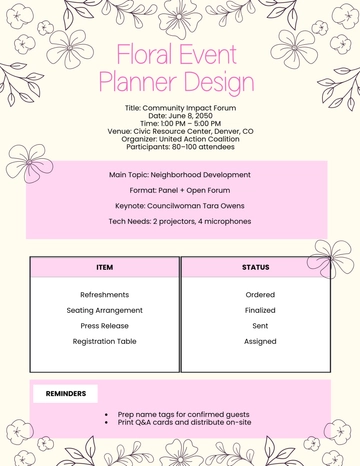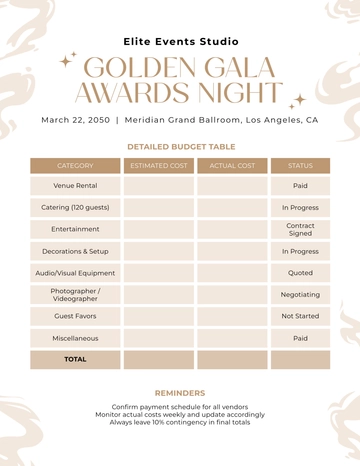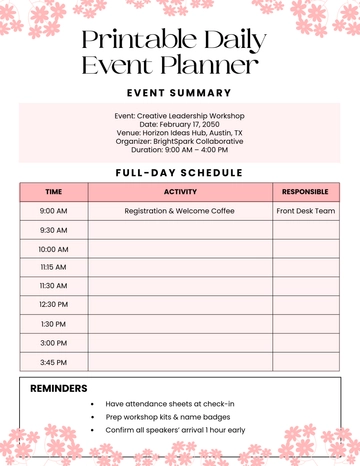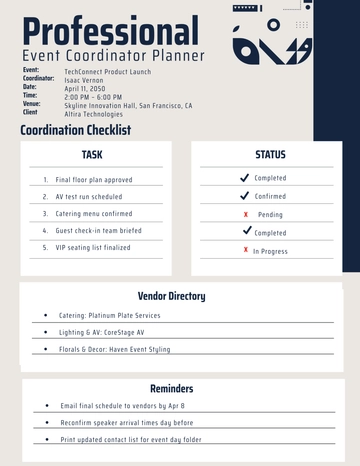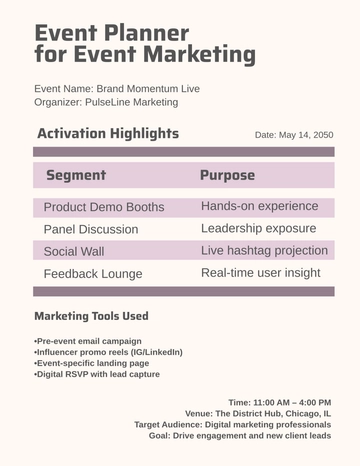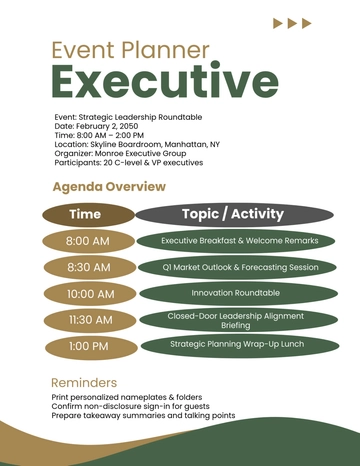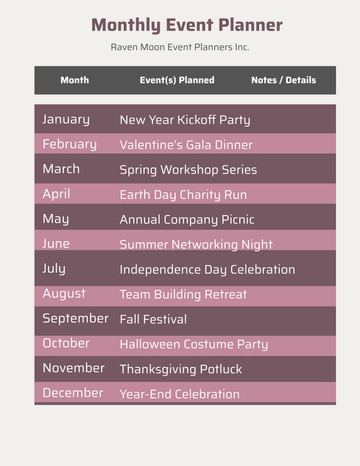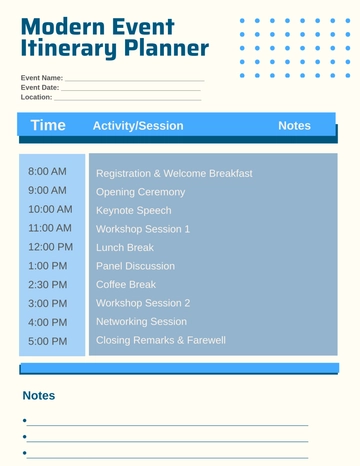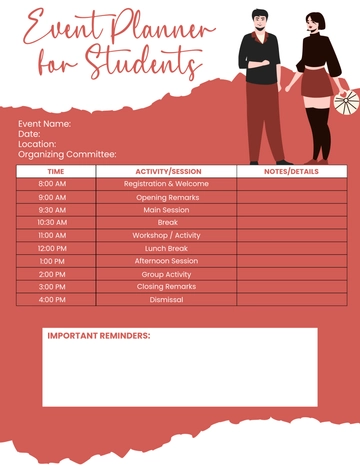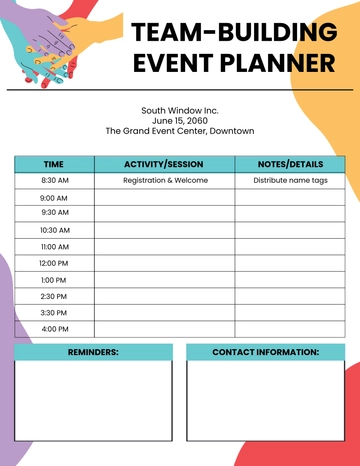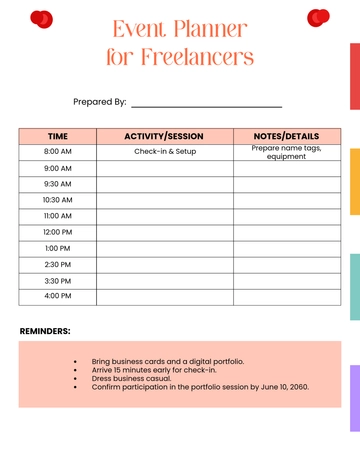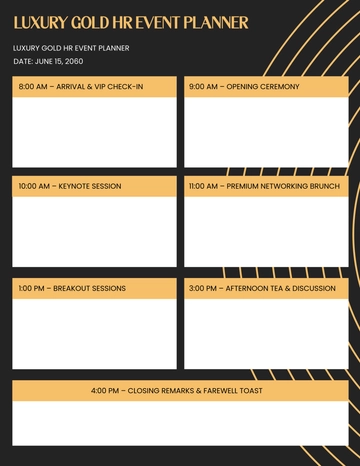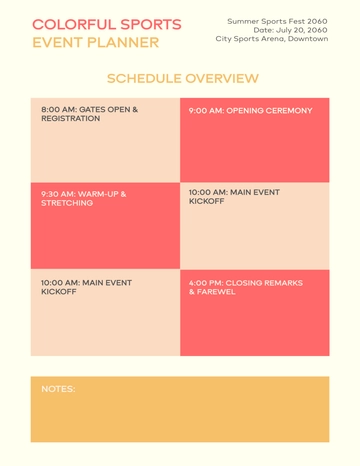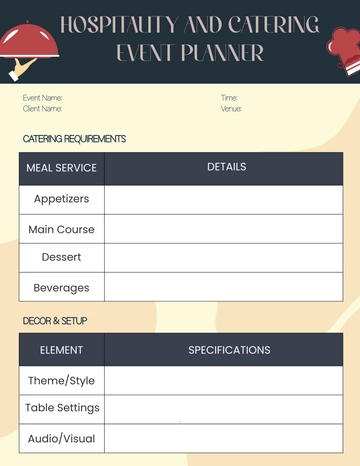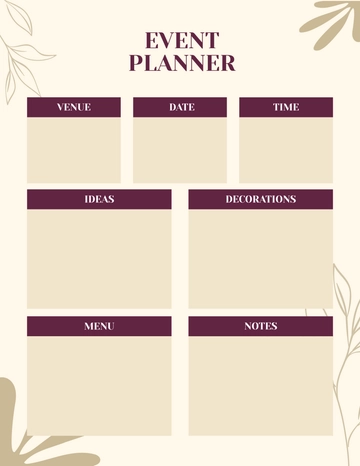Free Event Planner Report

Prepared for: [Your Company Name]
Prepared by: [Your Name]
Date: June 20, 2050
1. Introduction
The Annual Futurist Conference 2050 took place from June 1-3, 2050, at the prestigious [Venue Name] in [City]. This year’s theme, “Innovating for a Sustainable Tomorrow,” attracted a diverse group of attendees, including industry leaders, academics, and innovative entrepreneurs dedicated to exploring cutting-edge solutions for a more sustainable future. The conference featured renowned speakers, engaging workshops, and an extensive exhibit hall showcasing the latest advancements in technology and sustainability practices. This report provides a detailed overview of the event’s planning, execution, financial performance, attendee engagement, and recommendations for future improvements.
2. Event Overview
2.1 Objectives
The primary objectives for the Annual Futurist Conference 2050 included:
Enhancing Knowledge: To provide attendees with the latest insights into sustainable practices and innovative technologies that can transform industries.
Networking Opportunities: To foster collaboration among attendees, sponsors, and exhibitors to inspire partnerships that drive sustainable initiatives.
Showcasing Innovations: To highlight pioneering technologies and solutions through keynote speeches, panel discussions, and exhibits.
2.2 Key Features
The conference comprised several engaging features designed to enhance the attendee experience:
Keynote Speakers: The event hosted influential figures, including [Speaker Names], who shared their perspectives on future trends in sustainability and technology.
Panel Discussions: Dynamic discussions involving experts from various fields explored pressing global challenges and the potential solutions being developed.
Exhibitor Showcase: Attendees had the opportunity to explore [50] exhibitors presenting groundbreaking technologies, products, and services focused on sustainability.
3. Marketing and Promotion
3.1 Marketing Strategy
The marketing strategy aimed to reach a broad audience through targeted campaigns. Various channels were employed, including social media, email newsletters, and partnerships with industry influencers. Specific strategies included:
Social Media Campaigns: Engaging posts and ads on platforms like LinkedIn, Twitter, and Instagram increased awareness and anticipation leading up to the event. Influencers shared personal invitations to their followers, driving interest and registrations.
Content Marketing: Articles and blog posts about the conference's theme and featured speakers were published on industry-related websites, enhancing visibility and establishing authority.
3.2 Attendance Goals
The goal was to attract at least [4,000] attendees. Strategies focused on early bird ticket sales and group discounts to encourage registrations. Ultimately, attendance surpassed expectations, reaching [4,500] participants, demonstrating the strong interest in the conference theme.
4. Financial Overview
4.1 Budget Analysis
A thorough analysis of the budget reveals key areas of expenditure and variance from projections:
Expense Category | Budgeted Amount ($) | Actual Amount ($) | Variance ($) |
|---|---|---|---|
Venue Rental | [250,000] | [250,000] | [0] |
Marketing | [100,000] | [115,000] | [+15,000] |
Speaker Fees | [200,000] | [230,000] | [+30,000] |
Catering | [150,000] | [145,000] | [-5,000] |
AV and IT Services | [75,000] | [85,000] | [+10,000] |
Administration | [50,000] | [50,000] | [0] |
Miscellaneous | [25,000] | [30,000] | [+5,000] |
Total | [950,000] | [965,000] | [+15,000] |
The total budget was set at [950,000], while the actual expenditure reached [965,000]. The overall variance of [+15,000] indicates areas of overspending, particularly in speaker fees and AV services, which exceeded initial estimates. While this was an overspend, it can be attributed to the hiring of additional expert speakers and enhanced audio-visual equipment, which significantly elevated the quality of presentations.
4.2 Revenue Breakdown
The revenue generated through various channels was robust, highlighting the event's financial viability:
Revenue Source | Projected Revenue ($) | Actual Revenue ($) | Variance ($) |
|---|---|---|---|
Ticket Sales | [400,000] | [450,000] | [+50,000] |
Sponsorships | [300,000] | [350,000] | [+50,000] |
Exhibitor Fees | [150,000] | [180,000] | [+30,000] |
Merchandise Sales | [50,000] | [40,000] | [-10,000] |
Total Revenue | [950,000] | [1,020,000] | [+70,000] |
The actual revenue totaled [1,020,000], exceeding projections by [70,000]. This surplus was primarily driven by higher-than-expected ticket sales and sponsorships, validating the marketing strategies employed prior to the event. The robust sponsorship interest can be credited to our proactive engagement with potential sponsors, showcasing the conference's value and reach.
5. Sponsorship and Partnership Analysis
5.1 Sponsorship Overview
Sponsorship played a vital role in supporting the conference financially and enhancing its credibility. A diverse array of sponsors brought in various perspectives and resources:
Total Sponsors: The event secured [20] sponsors from various sectors, including technology firms, environmental organizations, and educational institutions. These sponsors not only provided financial backing but also enriched the conference content through their expertise.
Sponsorship Packages: Multiple sponsorship packages were offered, ranging from [$5,000] for the bronze level to [$100,000] for the platinum level. This tiered structure allowed organizations of varying sizes to participate, ensuring a broad spectrum of involvement.
Sponsor Feedback: Post-event surveys indicated that [90%] of sponsors were satisfied with their experience and felt that their expectations were met. Many cited the quality of networking opportunities and brand visibility as significant benefits. The sponsorship success demonstrated a strong alignment with our event theme, as many sponsors were deeply invested in sustainability initiatives.
5.2 Notable Partnerships
Key partnerships were established to bolster the event's impact and outreach, further enhancing the conference’s profile:
Media Partners: Collaborations with major media outlets, including Tech Innovators and Sustainability Today, provided extensive coverage before and during the event, amplifying our reach and credibility. The visibility gained through these partnerships significantly increased attendee interest.
Educational Institutions: Partnerships with leading universities facilitated the inclusion of research-based presentations and workshops, further elevating the event's credibility. Faculty members from these institutions led discussions on the latest research in sustainability, contributing to a rich academic dialogue.
Non-Profit Organizations: Collaborations with environmental non-profits helped promote sustainability initiatives, reinforcing the conference's theme and objectives. Their involvement also helped attract attendees passionate about environmental issues, enriching the overall experience.
6. Attendee Engagement and Feedback
6.1 Engagement Activities
To enhance attendee engagement, several interactive activities were incorporated throughout the conference. These activities were designed to foster participation and encourage deeper connections among attendees:
Networking Sessions: Organized networking events provided opportunities for attendees to connect with industry leaders and peers, fostering collaborations and discussions around shared interests. Structured networking sessions, including speed networking formats, were well-received and encouraged meaningful exchanges.
Workshops: Hands-on workshops allowed participants to engage deeply with topics of interest, with over [1,200] attendees participating in various sessions, including "Innovative Solutions for Waste Management" and "Building Sustainable Business Models." The interactive nature of these workshops facilitated practical learning and real-world application of ideas discussed.
Interactive Exhibits: The exhibit hall featured [50] exhibitors showcasing cutting-edge technologies and sustainable products, allowing attendees to interact with innovative solutions firsthand. Many attendees expressed enthusiasm for the opportunity to see new technologies in action, contributing to lively discussions around potential implementations.
6.2 Feedback Collection
Feedback was collected through various means to assess attendee satisfaction and gather suggestions for improvement, ensuring that all voices were heard:
Surveys: A post-event survey was distributed to all attendees, yielding a response rate of [65%]. The survey included questions on speaker quality, topic relevance, event organization, and overall experience. The responses provided a wealth of information that will guide future planning.
Focus Groups: Several focus groups were held with key stakeholders to gather in-depth insights into their experiences and suggestions for future events. These discussions yielded valuable qualitative data, highlighting both strengths and areas for growth.
6.3 Key Feedback Highlights
The feedback received was overwhelmingly positive, highlighting areas of success and opportunities for growth. Attendees provided constructive feedback that will shape future events:
Overall Satisfaction: [93%] of respondents indicated that they were satisfied or very satisfied with the conference experience, praising the quality of speakers and relevance of sessions. Many noted that the event exceeded their expectations, particularly in terms of content quality.
Speaker Quality: Participants consistently highlighted the expertise and engagement of speakers, with many suggesting the inclusion of even more diverse voices in future panels. The diversity of perspectives presented was appreciated, with attendees expressing interest in hearing from a broader range of experts.
Logistical Improvements: Suggestions for improvement included enhanced signage for navigation and a wider variety of catering options to accommodate dietary restrictions. These logistical details are vital for ensuring a smooth experience for all attendees.
7. Recommendations for Future Events
To continue building on the success of the Annual Futurist Conference, several recommendations have emerged from the feedback and observations gathered throughout the event:
7.1 Enhance Networking Opportunities
Implement more structured networking opportunities, such as speed networking sessions and themed discussion groups, to facilitate connections among attendees. Consider using a mobile app that allows attendees to connect based on shared interests and backgrounds, enhancing engagement.
7.2 Diversify Speaker Lineup
Aim to include a more diverse group of speakers in terms of gender, ethnicity, and professional background. This diversity will enrich discussions and provide attendees with a broader range of perspectives on sustainability.
7.3 Improve Logistics and Accessibility
Focus on improving logistical aspects, such as signage, session timing, and catering options. Ensure that all attendees, including those with dietary restrictions or disabilities, have access to a variety of options.
7.4 Increase Interactive Sessions
Consider incorporating more interactive sessions, such as workshops or hands-on demonstrations, to engage attendees actively. These formats can enhance learning experiences and encourage practical application of concepts discussed.
8. Conclusion
The Annual Futurist Conference 2050 was a resounding success, achieving its objectives of knowledge sharing, networking, and showcasing innovative solutions for a sustainable future. The overwhelmingly positive feedback from attendees, coupled with robust financial performance, underscores the value of the event. By implementing the recommendations outlined in this report, we can further enhance the quality and impact of future conferences. Thank you to all participants, sponsors, and partners for making this event a memorable experience.
- 100% Customizable, free editor
- Access 1 Million+ Templates, photo’s & graphics
- Download or share as a template
- Click and replace photos, graphics, text, backgrounds
- Resize, crop, AI write & more
- Access advanced editor
Document event outcomes with the Event Planner Report Template from Template.net. This editable and customizable template enables you to summarize key event details, performance metrics, and feedback. Tailor it with our Ai Editor Tool for comprehensive and professional event reporting.
You may also like
- Aesthetic Planner
- Hourly Planner
- Daily Planner
- Weekly Planner
- Monthly Planner
- Planners Yearly
- Event Planner
- Project Planner
- Calendar Planner
- Student Planner
- School Planner
- Teacher Planner
- Kawaii Planner
- Budget Planner
- Life Planner
- Meal Planner
- Study Planner
- Business
- Workout Planner
- Work Schedule Planner
- Party Planner
- Social Media Planner
- Baby Shower Planner
- Book Planner
- Planner Cover
- Debt Planner
- Desk Planner
- Diet Planner
- Family Planner
- Fitness Planner
- Goal Planner
- Health Planner
- Medical Planner
- Holiday Planner
- Homework Planner
- Itinerary Planner
- Journal Planner
- Personal Planner
- Route Planner
- Smart Goal Planner
- Travel Planner
- Wedding Planeer
